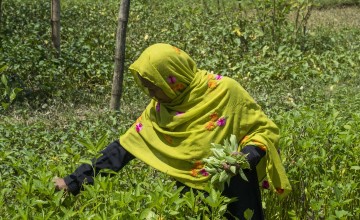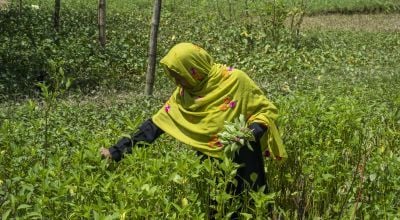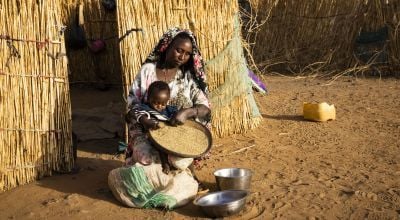
Read our 2023 annual report

Knowledge Hub
There is no single, easy solution to world hunger, but that does not mean it cannot be solved.
A wide array of strategies are available to us, both at an institutional level and an individual level, that can help end hunger for good. You’ve come to the right place to find out what they are.
Concern has been working in the world’s poorest countries for over fifty years, with a focus on ending hunger as part of our larger goal to end extreme poverty. Our programmes tackle the root causes of hunger and our innovative solution for treating malnutrition has been at the forefront of the global response for decades.
Why is world hunger a problem?
The world actually managed to reduce hunger significantly from 1991 to 2014. Since then, however, it has been slowly on the rise. A combination of conflict, the climate crisis, and the knock-on effects of COVID-19 have left the world losing progress in the fight for Zero Hunger.
» Learn more about the causes of world hunger.
Although the climate crisis is currently having a greater impact in low and middle income countries, the increasingly dependent nature of our food systems means that our global food system as a whole will come under threat. Ultimately, we are all at risk from hunger.
Ending world hunger is possible. But it requires political and collective action to actually achieve it. The solutions are there.

How to solve world hunger
No single idea will solve world hunger alone. But there is a range of solutions available to us, from an institutional to an individual level that, collectively, can bring us to zero hunger. The following nine solutions are all approaches adopted and promoted by Concern that can be implemented at a local and national level by governments and other state bodies.
1. Boost social protection programmes, especially for the most vulnerable

Social welfare systems have proved to be hugely effective forms of support. But for many of the world’s most vulnerable communities, there is no such social safety net in times of crisis. We aim to provide this support through our cash transfer programme in countries like Somalia. It is the world’s poorest and most vulnerable communities that are worst affected by hunger. By identifying these groups and supporting them first, we can eliminate hunger.
» Learn more about the link between extreme poverty and hunger.
2. Switch to Climate Smart Agriculture

Climate change and hunger exist in a vicious cycle. More frequent and longer-lasting periods of extreme temperatures, flood events, and dry spells leave many families — especially those who work in agriculture — unable to put food on the table. Climate Smart Agriculture (CSA) is a broad term that encompasses a number of practices. But all of these solutions allow farmers to adapt and become more resilient against an unpredictable climate.
These practices include diversifying crop varieties, conservation agriculture, and low-water sack gardens. Time and again, we’ve seen families benefit both nutritionally and financially from these solutions.
» Learn more about Climate Smart Agriculture.
3. Fostering gender equality

Gender equality is another priority solution to world hunger, especially in two key areas: agriculture and maternal and child health. Women make up approximately half of the agricultural workforce in many of the countries where Concern works, and data from the Food and Agriculture Organization suggest that giving female farmers equal access to resources as their male counterparts could increase production on their farms by 20-30%. This could in turn reduce the number of hungry people in the world by up to 150 million.
Hunger affects maternal health, making female nutrition essential to ending hunger. According to the World Food Programme, women are more likely than men to go hungry in nearly two-thirds of the world’s countries. By prioritising women’s health and nutrition, we can prevent not only health complications for them if and when they have children, but also for the children they bear. This begins with puberty and continues through pregnancy, breastfeeding, and on through healthy habits that children can maintain for the rest of their lives.
» Learn more about women and hunger.
4. Strengthen food systems

A food system is the cycle in which food is produced and prepared for people to then buy, cook, and eat. All parts of these systems need to be working in order to ensure that communities reach low levels of hunger and malnutrition and have a form of stability in their health and nutrition on which they can build a stronger community overall. By ensuring that people not only have enough food today, but that they also have the means of getting enough food every day, we’re able to get one step closer to Zero Hunger.
» Learn more about food systems.
5. Improve hygiene and sanitation
Even when families have enough food to eat, if they don’t have access to water, sanitation and hygiene, they become susceptible to diarrhoea and other waterborne diseases that could prevent them from absorbing the necessary nutrients from their food. Children are particularly vulnerable to becoming malnourished in this way. A huge focus of our health programme is ensuring that people have access to clean, safe water and adequate hygiene and sanitation services.
6. Promote disaster risk reduction

Investing in disaster risk reduction — especially in vulnerable communities — mitigates potential losses in the wake of disasters for those who stand to lose the most. Most of the people with whom we work are involved in subsistence agriculture, meaning that they grow what they eat. For many, their harvests are never enough, and the prospect of losing what they do grow is the very definition of disaster. Simple techniques to protect and diversify crops can be very effective.
Protecting the homestead and livestock is important too; losing vital shelter and assets can quickly lead to hunger. This can range from having evacuation procedures in place for areas prone to cyclones: to infrastructural measures such as retaining walls in flood prone areas or natural resource management such as reforestation in areas prone to extreme climate conditions.
» Learn more about disaster risk reduction.
7. Support refugees

Forced migration is a key cause of hunger, and we are currently in the middle of an unprecedented global refugee crisis. Refugees and IDPs are some of the most vulnerable groups when it comes to hunger. So are their host communities, whose resources are often very thinly spread.
Much of the work to stop conflict needs to take place on a government and policy level, but one way Concern can help is through programs that facilitate new ways to generate income. For example, Syrian refugee women and their Lebanese neighbours have learned how to make staples like cheese and yoghurt, and how to sell them at market for a profit. For those who wish to return home to Syria, this will also be an essential skill to have when the country eventually rebuilds its infrastructure.
8. Improve storage systems

When communities have a successful harvest, they need to have access to a safe storage system to ensure their food supply lasts. Some of the solutions we employ range from building or rehabilitating grain stores to innovations such as solar dryers. They work by accelerating the traditional practice of sun-drying which preserves micronutrients and prolongs shelf lives. Solar dryers are eco-friendly devices that also reduce contamination and minimise nutrient loss.
9. Reduce food waste

Currently, one-third of all food produced is wasted — that's over 1.3 billion tons. Producing this wasted food also wastes other natural resources. It requires an amount of water equal to the annual flow of Russia’s Volga River, and creates 3.3 billion tons of greenhouse gases.
Ending food waste would be a radical shift, but it’s one that you can be a part of by simply reducing your own food waste. It’s especially important in countries like Ireland (which contribute more to climate change but feel the effects less than more vulnerable countries) to take these steps towards climate justice. You can also ask your representatives to commit to policies that reduce waste and better the whole food system.
» Learn more about what you can do to help solve world hunger.
How Concern is working to solve world hunger
Concern’s programmes incorporate all of the elements laid out above, as we seek to both treat and prevent hunger. We also engage with local and national governments to ensure these strategies are implemented at an institutional level.
In terms of treating hunger, we support national governments in strengthening their health systems to provide quality treatment for acute malnutrition using the Community Management of Acute Malnutrition (CMAM) approach. We work on behaviour change towards improved Infant and Young Child Feeding practices (IYCF) often through women’s groups such as care groups or mother-to-mother support groups. Our treatment strategies also intertwine with our agriculture activities to ensure that households produce a more diverse range of fruits, vegetables and grains to meet the nutritional needs of women and children.
In terms of prevention, our programmes seek to tackle the root causes of hunger, such as poverty and inequality, and to mitigate against the effects of crises such as conflict and climate change.





